Stunning Madaba Map: Oldest Known Mosaic Built Of Two Million Stone Cubes
A. Sutherland - AncientPages.com - The map of Madaba is the oldest known and existing geographic floor mosaic map of the Holy Lands in art history.
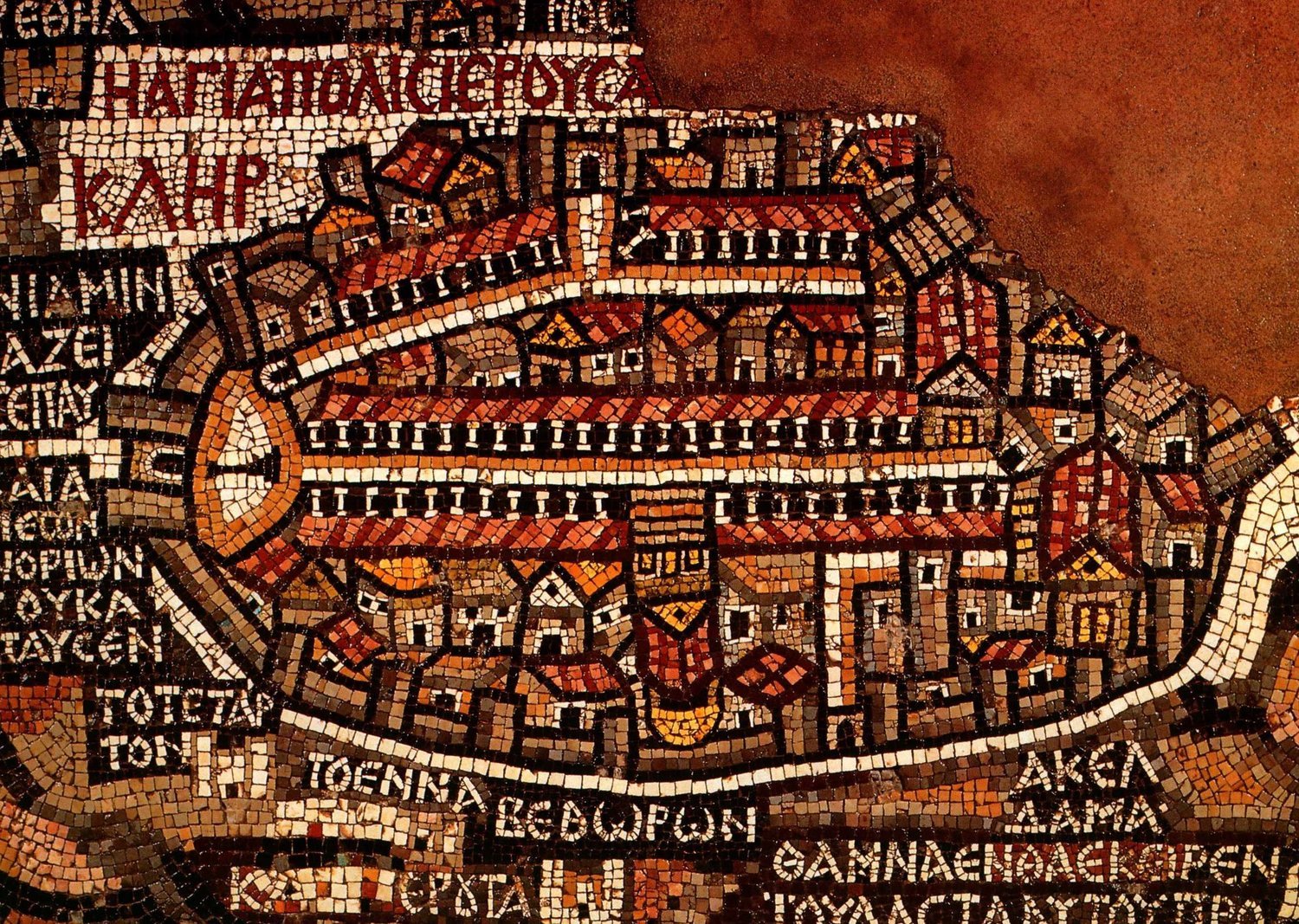 The fragment that depicts Jerusalem. Walls are visible around the big cities, including Jerusalem, Jericho, and Ashdod. Jerusalem is the focus of the map. The Madaba Map Centenary, 1897-1997 - Unknown author - Public Domain
The fragment that depicts Jerusalem. Walls are visible around the big cities, including Jerusalem, Jericho, and Ashdod. Jerusalem is the focus of the map. The Madaba Map Centenary, 1897-1997 - Unknown author - Public Domain
This beautiful and colorful work of ancient artists (or perhaps cartographers) who had both skills and biblical knowledge shows very accurate locations of the area, from Tyre in the north to the Egyptian Delta in the south, with all mountains, rivers, and the major cities.
The map that was created between 542 and 570 covers the floor of the Basilica of St. George in the city of Madaba ("the city of mosaics") in Jordan, about 15 miles southeast of the northern part of the Dead Sea.
The history of Madaba (mentioned in the Bible and on the Mesha Stele) goes back thousands of years. The first settlements in the area formed there in the 4th millennium BC. At the time of the Exodus and conquest, 1406 BC, Madaba, and Mt. Nebo were part of the territory of Moab. (Isa 15:2; Num 36:1; Deut 32:49.)
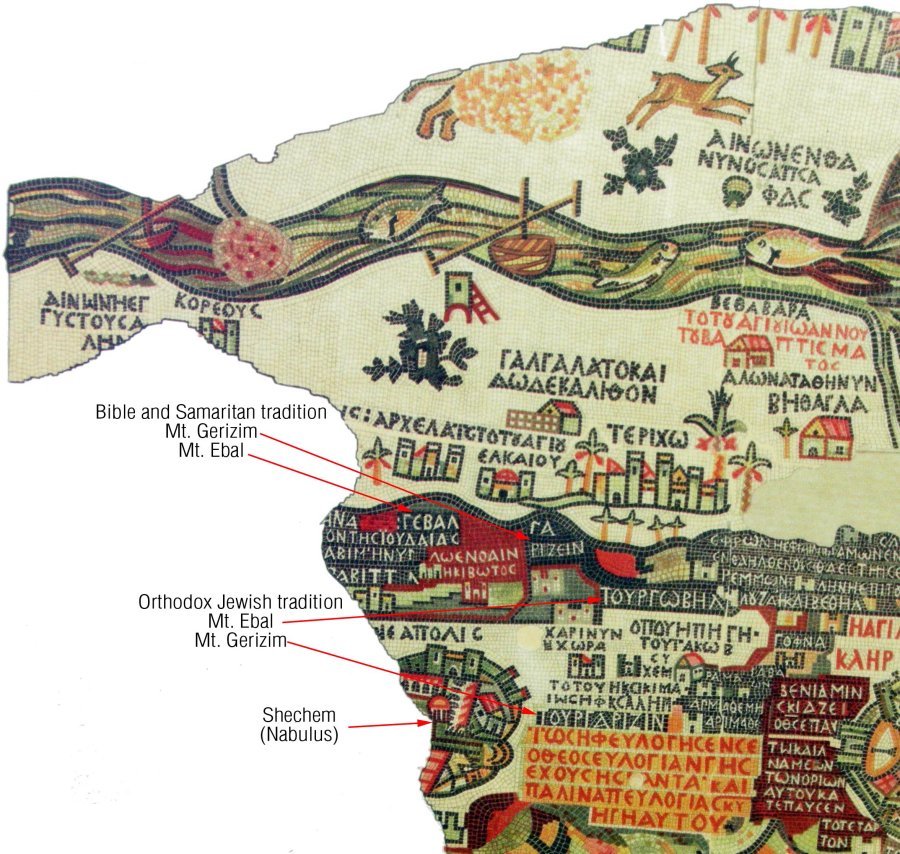 Madaba Map of Biblical Lands. Image credit: Bible ca.
Madaba Map of Biblical Lands. Image credit: Bible ca.
Taken by the Amorite king Sihon, which happened shortly before Joshua's conquest of Canaan, the Israelites passed through, took the city of Madaba, and conquered Sihon.
According to 1 Maccabees 9:32-42, Madaba was inhabited by a Nabataean tribe, the sons of Jambri, in the 2nd century BC.
Madaba had a long and turbulent history of being constantly captured by one enemy and passed back and forth from one conqueror to another.
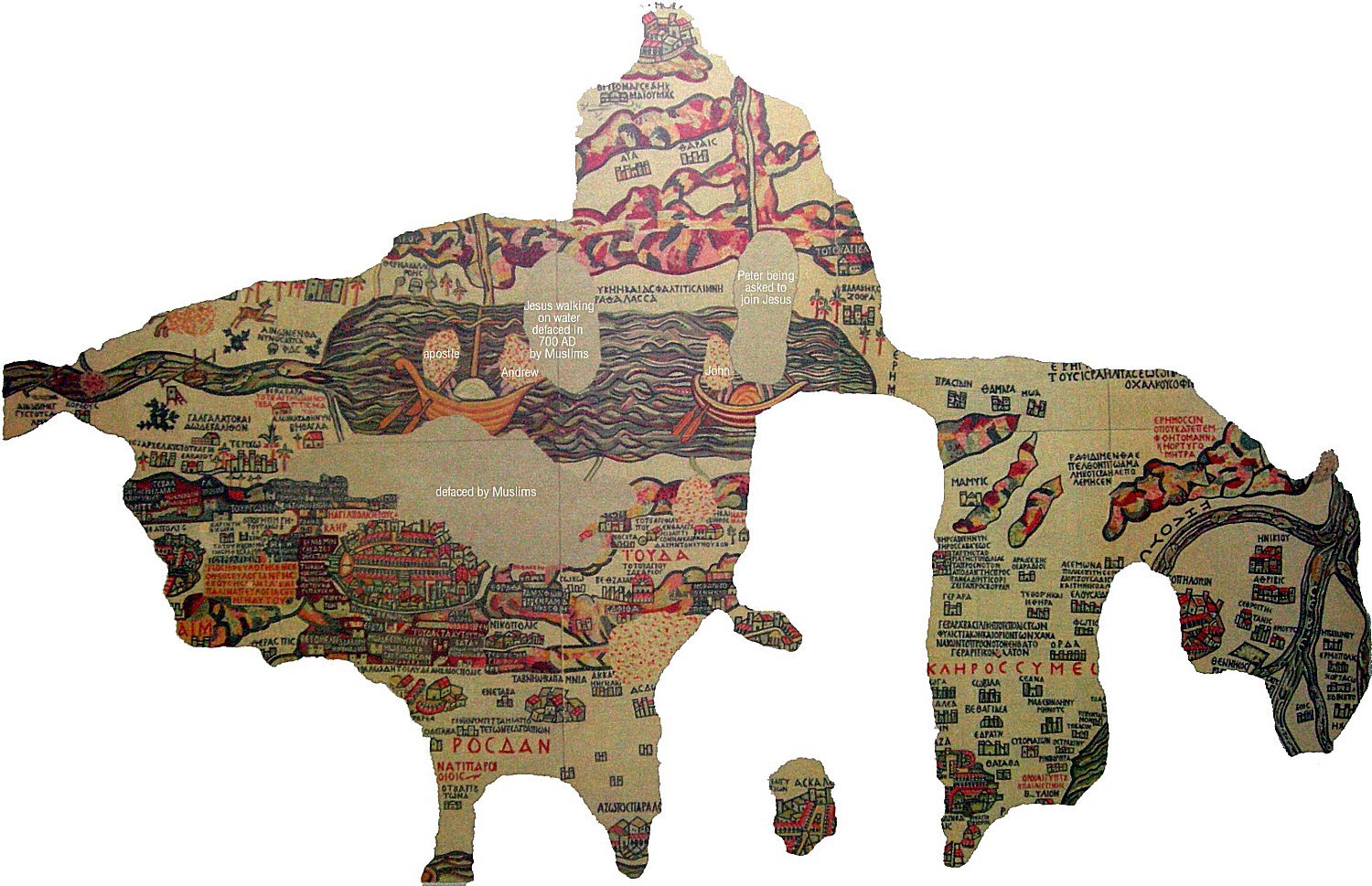 Madaba Map is considered by some scholars to be the best topographic representation ever done before modern cartography. Image credit: bible.ca
Madaba Map is considered by some scholars to be the best topographic representation ever done before modern cartography. Image credit: bible.ca
The map was initially created during the reign of emperor Justinian, 527-565 AD. It was formed of 2 million colored cubes and measured about 51 feet x 19.5 feet (15.5 m x 6 m).
The present remains of the map are composed of 750,000 cubes measuring 34.5 feet x 16.5 feet (10.5 m x 5 m and 150 Greek inscriptions in various sizes.
The most detailed element of the topographic depiction is Jerusalem, located at the center of the map. The anonymous artist accurately portrayed the old buildings of Jerusalem's Old Town, its gates, and some facilities, such as the Basilica of the Holy Sepulcher, Gethsemane, and the Citadel of David.
 Madaba Mosaic Map on the floor of the Basilica of St. George in the "city of of mosaics” in Jordan. Image credit: Visitpalestine.ps
Madaba Mosaic Map on the floor of the Basilica of St. George in the "city of of mosaics” in Jordan. Image credit: Visitpalestine.ps
Archaeological excavations conducted in 2010 further substantiated its accuracy with the discovery of a road depicted on the map that runs through the center of Jerusalem.
There are also clearly depictions of the Dead Sea, the bridges connecting the banks of the Jordan, river fish, and lions hunting gazelles on the Moab steppes, as well as cities, such as the Jericho palms and sacred places of Christians such as Bethlehem.
The mosaic was rediscovered in 1884 during the construction of a new Greek Orthodox church. In 1965-1966, the map was rediscovered and described by German archaeologists. All objects shown on the map are represented in Greek.
The unknown artists probably made the map for the Christian community of Madaba, which was the bishop's seat at that time. In 614, Madaba was conquered by the Sasanian Empire. In the eighth century, the ruling Muslim Umayyad Caliphate had some figural motifs removed from the mosaic.
Patriarch Nicodemus I of Jerusalem was informed about the incident, but no research was carried out until 1896 AD.
Unfortunately, large portions of the Madaba Map were damaged by fires and moisture effects that destroyed the art's quality. In 1965, major restoration works were undertaken to restore the remaining parts of the mosaic.
Written by – A. Sutherland - AncientPages.com Senior Staff Writer
Updated on September 29, 2022
Copyright © AncientPages.com All rights reserved. This material may not be published, broadcast, rewritten or redistributed in whole or part without the express written permission of AncientPages.com
Expand for referencesReferences:
Aa.Vv. The Mediterranean Medina: International Seminar
More From Ancient Pages
-
 Waru Waru – Ancient Andean Irrigation System Brought Back To Life
Ancient History Facts | Apr 28, 2018
Waru Waru – Ancient Andean Irrigation System Brought Back To Life
Ancient History Facts | Apr 28, 2018 -
 The ‘Band Of Peace’ And Ancient Egyptian Technology – Is It Possible These Sites Were Power Generators?
Ancient Mysteries | Mar 19, 2017
The ‘Band Of Peace’ And Ancient Egyptian Technology – Is It Possible These Sites Were Power Generators?
Ancient Mysteries | Mar 19, 2017 -
 Powerful Winds In Ancient Beliefs
Featured Stories | Feb 5, 2024
Powerful Winds In Ancient Beliefs
Featured Stories | Feb 5, 2024 -
 What Did Ancient Mesoamerican Civilizations Know About Unusual Powers Of The Mind?
Ancient Mysteries | Feb 13, 2020
What Did Ancient Mesoamerican Civilizations Know About Unusual Powers Of The Mind?
Ancient Mysteries | Feb 13, 2020 -
 Many Samurai Had Swords With Secret Crucifixes And Hidden Christian Symbols To Avoid Persecution
Ancient History Facts | Jan 10, 2017
Many Samurai Had Swords With Secret Crucifixes And Hidden Christian Symbols To Avoid Persecution
Ancient History Facts | Jan 10, 2017 -
 Human-Driven Mass Extinction Is Eliminating Entire Branches Of The Tree Of Life – New Study
Biology | Sep 19, 2023
Human-Driven Mass Extinction Is Eliminating Entire Branches Of The Tree Of Life – New Study
Biology | Sep 19, 2023 -
 On This Day In History: Great Siege Of Gibraltar Begins – On June 16, 1779
News | Jun 16, 2016
On This Day In History: Great Siege Of Gibraltar Begins – On June 16, 1779
News | Jun 16, 2016 -
 Apollo – Loved And Feared Greek God Of Divination And Prophecy Who Was Also Seer Of Zeus
Featured Stories | Feb 6, 2019
Apollo – Loved And Feared Greek God Of Divination And Prophecy Who Was Also Seer Of Zeus
Featured Stories | Feb 6, 2019 -
 New, Unique Wall Paintings Discovered In Old Dongola, Sudan
Archaeology | Apr 10, 2023
New, Unique Wall Paintings Discovered In Old Dongola, Sudan
Archaeology | Apr 10, 2023 -
 Traces Of An Unknown Ancient Race Of Winged Beings And Other Mysterious Creatures Discovered In Japan
Ancient Mysteries | Nov 30, 2018
Traces Of An Unknown Ancient Race Of Winged Beings And Other Mysterious Creatures Discovered In Japan
Ancient Mysteries | Nov 30, 2018 -
 Empusa – Shape-Shifting Evil Female Demon In Greek Myth And Folklore
Featured Stories | Jun 3, 2020
Empusa – Shape-Shifting Evil Female Demon In Greek Myth And Folklore
Featured Stories | Jun 3, 2020 -
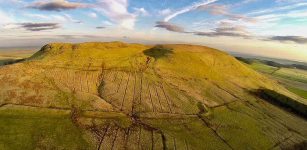 Archaeologists Discover Over 100 Ancient Settlements North Of Hadrian’s Wall
Archaeology | May 26, 2022
Archaeologists Discover Over 100 Ancient Settlements North Of Hadrian’s Wall
Archaeology | May 26, 2022 -
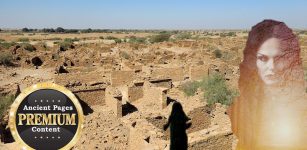 Ancient Mystery Of The Village Where All Residents Vanished Overnight
Ancient Mysteries | Oct 19, 2021
Ancient Mystery Of The Village Where All Residents Vanished Overnight
Ancient Mysteries | Oct 19, 2021 -
 Massive trophy skull rack discovered in the Aztec ruins
Artifacts | Aug 22, 2015
Massive trophy skull rack discovered in the Aztec ruins
Artifacts | Aug 22, 2015 -
 Hidden Connection Between The Zodiac, Ancient Egypt, Freemasonry And Christianity
Ancient Mysteries | Aug 14, 2018
Hidden Connection Between The Zodiac, Ancient Egypt, Freemasonry And Christianity
Ancient Mysteries | Aug 14, 2018 -
 Ancient Settlement Inhabited By Urartian People – Unearthed
Archaeology | Oct 13, 2020
Ancient Settlement Inhabited By Urartian People – Unearthed
Archaeology | Oct 13, 2020 -
 Cyrus The Great Cylinder – Legacy Of The Ancients
Artifacts | Aug 25, 2015
Cyrus The Great Cylinder – Legacy Of The Ancients
Artifacts | Aug 25, 2015 -
 Mystery Of The Kusanagi Treasure: The Legendary Sword
Artifacts | Feb 8, 2016
Mystery Of The Kusanagi Treasure: The Legendary Sword
Artifacts | Feb 8, 2016 -
 Unraveling The Mystery Of The Celestial Matrix
Ancient Mysteries | Sep 30, 2021
Unraveling The Mystery Of The Celestial Matrix
Ancient Mysteries | Sep 30, 2021 -
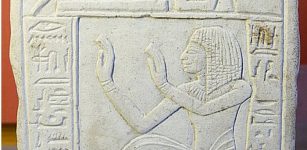 Meretseger: Theban Cobra Goddess Who Presided Over The Valley of The Kings
Egyptian Mythology | Jul 10, 2021
Meretseger: Theban Cobra Goddess Who Presided Over The Valley of The Kings
Egyptian Mythology | Jul 10, 2021
